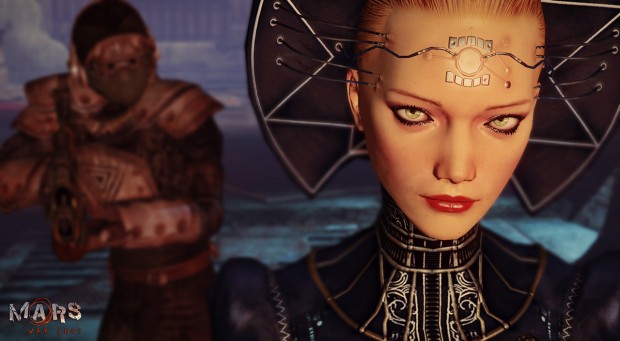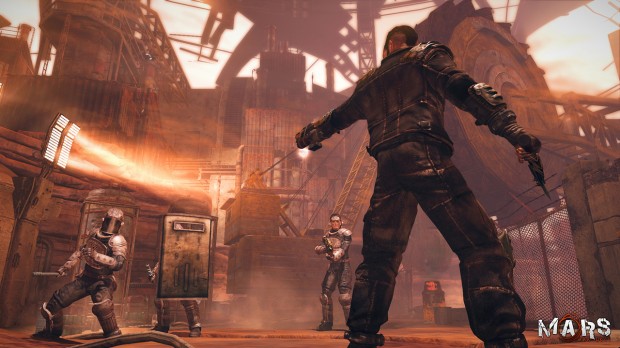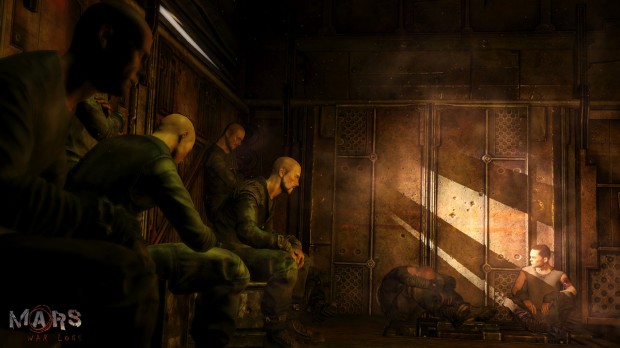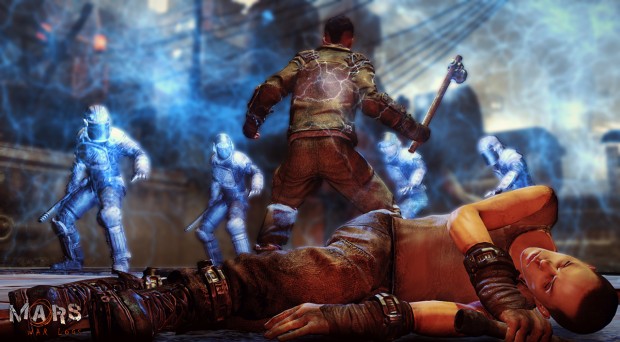Mars: War Logs review (XBLA)
Mars: War Logs was developed by Spiders Studios and published by Focus Home Interactive. It was released July 26, 2013 for 1,200 MSP. A copy was provided for review purposes.
Mars: War Logs is a sci-fi/action RPG that is unmistakably, unabashedly cut from the same basic template used for Knights of the Old Republic, Jade Empire, and Mass Effect. The main character is a war veteran with a dark, mysterious, or troubled past. He or she travels with a few companions who provide assistance, special abilities, additional information, and so on. The villain is either an oppressive fascist regime or someone who harbors deep personal resentment for the hero. Throughout the journey, the party is faced with moral dilemmas as they seek to resolve primary tasks and sub-quests, with decision options usually broken down into a binary GOOD or EVIL choice and little in-between. There is an equipment upgrade system, where the player uses spare materials to enhance weapons and armor. The party gains experience points to level up, and skill points can be applied to unlock advanced abilities, feats, and class perks. There are romance options available, depending on the hero’s gender, demeanor, and rapport with his or her companions. This game format is very familiar to anyone who has played any high-profile console RPGs in the past ten years, and even more so for those running the original Baldur’s Gate on PC in the late 1990’s.
So let’s just get this out of the way, rather than meandering around it: if someone is interested in playing a sci-fi/action/open-ended WRPG, they have a ton of options available from half a dozen extremely prolific developers, some of whom started the genre. Many of those options are incredible adventures, spanning entire galaxies, with memorable characters, brilliant dialogue, breathtaking landscapes, and a few of them have dramatically pushed the genre forward in big ways. The market is immensely crowded, and Mars: War Logs is placed in a very tough spot because of that. Priced between $15 and $20, it is clearly aimed to be a mid-priced alternative to mega-funded RPGs from the likes of BioWare and Obsidian, and wants to be a Mass Effect that doesn’t cost $60 at launch. But the size of the budget and price of the game are but small parts of a much larger picture, so how does Mars: War Logs measure up?
Here’s what we liked:
The basic premise – While the game might not do anything terribly revolutionary with its setting, and we would have preferred that it did more with the prison camp rather than stumbling through the first act, the fact is, breaking out of prison is not a premise we see very often, and it’s refreshing to see it here. It echoes Chronicles of Riddick: Escape from Butcher Bay, for better or for worse. At best, it does something very few games even attempt. At worst, it invites pacing comparisons against one of the most well-paced and creative games ever released, and Roy, the hero in War Logs, doesn’t exactly stand up to Vin Diesel’s graveled, subdued menace. Interacting with guards and prisoners is a nice touch, though again, it’s very simplistic, and lacks the punchy nuance and style found in Riddick. The prison is set against the backdrop of a large-scale post-apocalyptic civil war, which is also fairly unique for the genre, though the game does still fall into conventional story beats, since one side IS still an oppressive fascist regime fueled by fundamentalist theological doctrine.
The combat – Fights are fast and furious, and require a surprising amount of on-the-fly strategizing. At a base level, the game is a brawler, with light and heavy attacks, evasion rolls, lock-on targeting, and a decent block/parry mechanic. Companions can be given instructions, as well, but this is usually no more complex than simple dog commands like Stay, Attack, Heel, and so forth. The power wheel is ripped straight from Mass Effect: open wheel with Left Bumper, select powers with A, set powers on hot keys with LT, RT, and RB. It’s such a blatant design grab that we would expect Apple and Samsung to sue each other over it.
Lots of different things to kill – Enemy variety forces gamers to mix up their strategies; some enemies wear goggles or masks, so they cannot be blinded by dirt, while others block light attacks or wear heavier armor, necessitating a heavy attack to break through the block or rolling behind the foes to target their weak spots. Early on, the game mostly throws melee enemies at your team, but quickly tosses in a few riflemen, and occasionally, a Technomancer (the Sith class). While gamers can likely survive a ranged/melee mix by ordering the companions to distract the gunners, fighting a Technomancer requires a significant strategic overhaul, and ultimately resembles more trial-and-error than a test of skill. Couple that frustration with a lot of cheap hits, slow character speed, and unavoidable chip damage, and fun and fast-paced quickly becomes repetitive and grinding. It certainly doesn’t help matters when the Technomancy powers LOOK so underwhelming, either. They may seem like Force powers or Biotics, but they lack that visual punch.
Lots of skills to unlock – The skill system is pretty varied, with a bunch of neat abilities spread across three trees (combat, stealth, and Technomancy), though the Technomancy tree is initially locked for plot reasons, which straight up spoils the “surprise” when Innocence discovers that Roy used to be a Technomancer. It’s a reveal that feels like it was intended to function like the Revan twist in Knights of the Old Republic 1, but it has nowhere near the impact, because the game doesn’t build up to it at all. It just happens. M:WL borrows what works in other games without realizing WHY it works, and what the other games do to make it work. As a consequence, as amusing as the Technomancy abilities can be, the Technomancer tends to come off as a poor man’s Sith Lord.
Here’s what we didn’t like:
The writing – The game opens on a train transporting a number of characters to a prison camp. Here, we are introduced to Innocence, who laments over his treatment as a prisoner of war. He makes a few awkward observations about the nature of war, violence, and torture, then mentions having been in prison cells so long that he doesn’t know if it’s night or day…while the train is brightly lit, with a gigantic beam of sunlight right in his face. It’s a glaring script/shot inconsistency, and this is the first scene of the game. At the prison, Innocence is shoved into the sand showers to clean up, and is immediately targeted by Fatso, the town rapist. Fatso’s speech here is a turgid mess of expletives and mixed metaphors, somewhat resembling Biff Tannen but without a sharp script and Thomas F. Wilson’s strangely irresistible charm. As Innocence is about to lose his innocence (get it?), Roy intervenes and saves him. The two decide to work together to escape. The execution is lackluster and dull, though, thanks to the poor script and questionable voice acting.
The character names – Every character from the guild, Aurora, has virtue-based names. Names like Innocence, Devotion, Temperance, and Honor. Virtue names belong in Greek tragedy, Romantic poetry, and high school fiction workshops. M:WL is certainly not Oedipus, nor can it lay claim to equal footing with Wordsworth, Byron or Keats. To be fair, the game does explain the naming convention, and a few side characters do mock it, so it’s not entirely straight-faced, but it’s still serious enough to discard any pretense of ironic genre parody. Character names should fit personalities, surely, but the names here are far too on-the-nose, far too blatant, used to define characters rather than engage in any meaningful character development, and turns them all into cardboard. If the game had been a tongue-in-cheek parody, and if there happened to be some sort of drinking metagame for every time a virtue name sounded ridiculous, it would be brilliant (and gamers would be passed out halfway through the prison). As it stands, though, the game actually takes itself, and its virtue names, seriously.
The tertiary characters and side quests – Most side characters are completely uninteresting, with very little to say, and those that do speak more than a couple of sentences are so poorly conceived that we almost wish they would have just been signposts. Quests are absurd to the point of nonsensical, with the game occasionally clumsily throwing in an arbitrary Good/Evil choice, purely for the sake of having one. This morality system is incredibly dated, as well, failing to provide the player with clear feedback, offering almost no indication whether an action will be considered good or bad, and lacking the refinements implemented in Mass Effect 2 and Alpha Protocol. Exchanges with these characters are laughably bad, made worse by the clumsy attempt to inject a “profound” sense of gravitas, and would have been far better had the quest been shoved onto a bounty board a la Borderlands, a game that perfectly deconstructed the side quest NPC: just a bunch of text on a bulletin board.
Control and camera – Control is mostly serviceable, though there is a definite disconnect between input and on-screen response. It isn’t input lag so much as animations needing time to complete before the action or ability actually triggers. There were multiple occasions when Roy used two healthpacks when we’d intended to use one, and the animation issue greatly interferes with combat, since enemies don’t seem to operate under the same limitations. Further, the camera is archaic. The industry has had since 1996 to figure out the best ways to move a character and camera in 3D space. Most games have no camera issues. Mars: War Logs stands alone, however; Roy can be sprinting down a corridor, turn a corner, and enter a water pump, and the camera will still be pointed in the same exact direction prior to the sprint. The only ways the player is able to re-position the camera are by swiveling the right joystick or click it to re-center. Unless there is a sub-menu hidden somewhere, there is no way to enable auto-position. This is 2013. The industry moved past this five years ago.
While its ambition is commendable, and there is some fun to be had with the combat and upgrade systems, Mars: War Logs is ultimately done in by its lack of visual and mechanical polish, uneven writing, flat characters, and offputtingly humorless tone. Further, and probably most damning of all, it is a game of “if only it had.” If only it had been released on the original Xbox in 2004. If only it had been released on the Xbox 360 in 2008. If only it had not been released at a time when the Mass Effect trilogy could be purchased for $15. The game just doesn’t match up to the price.
Score: Skip It





